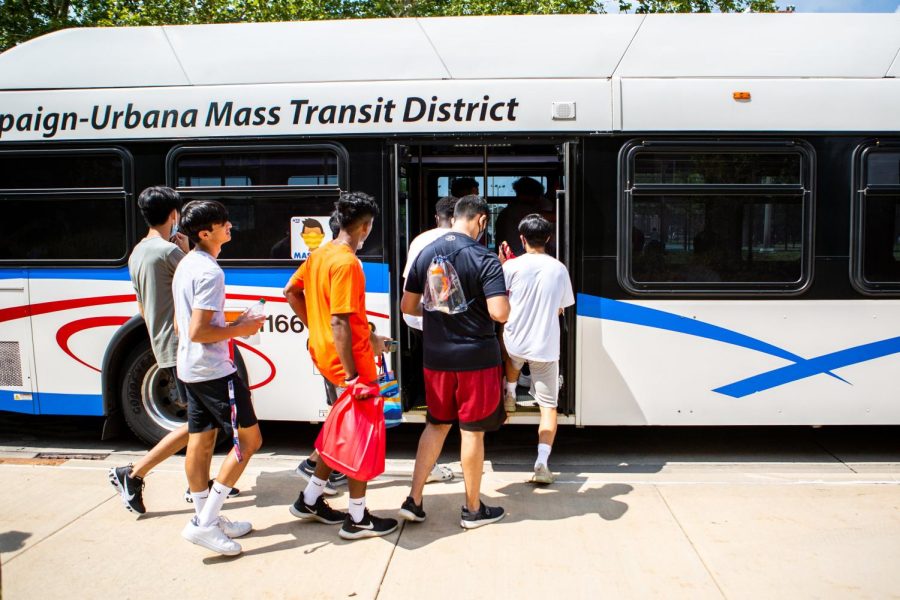Bus driver shortage continues despite MTD efforts
Students catch the 10E Gold MTD bus after Freshman Welcome Celebration and Convocation on Aug. 20, 2021.
Sep 21, 2022
The Champaign-Urbana Mass Transit District continues to face a shortage of bus operators, which has led to MTD implementing service reductions to some of its bus routes.
“Just like when you go to a restaurant or try to access a service, or you go to a grocery store and the shelves aren’t stocked, everybody is really struggling to get people to come to work,” said Amy Snyder, chief of staff for MTD.
Snyder said MTD started to reduce service due to the bus operator shortage during the fall of 2021.
“We tried really hard to keep as much service on the street for as long as we could,” Snyder said. “But we could not keep pace with the operators that were needed with the operators that we were losing.”
Snyder later said that the MTD is down about 22% from pre-pandemic school-year service.
Get The Daily Illini in your inbox!
“We’re back to some pretty impressive loads,” Snyder said. “We need more frequency, but we just can’t sustain that right now with the current workforce we have.”
The results of these service reductions are seen in the day-to-day life of University students across campus and CU residents as well.
The 22/220 Illini, for example, moved from variable 10-20 minute frequencies to 15-minute daytime frequencies as part of a series of changes last May, although buses can still struggle to hit these times.
While most MTD bus routes have been affected in some capacity, routes with similarly changed frequencies include the 12 Teal and the 13/30 Silver.
Snyder said some community routes were cut down to 45-minute and hour frequencies.
One SafeRide vehicle was also cut, though students should expect only “slightly longer wait times,” according to Snyder.
Courtney Bilbro, freshman in ACES, said she has not had any major problems with buses, but she does know people that have.
“My friend, not too long ago, couldn’t go to class because her bus came late,” Bilbro said.
Whereas in the past the 22/220 Illini route had eight buses servicing the route, MTD had to cut down that number to five, a significant dent in the efficiency of the route, according to Snyder.
“For the (22/220) Illini to run the big loop that it does — the very circuitous Illini route — in order to do 10-minute frequency during weekday/daytime you need eight buses,” Snyder said.
When it comes to retaining bus drivers, Snyder said about 60-65% of bus drivers who resign from their post do so within the first 12 months.
“Those first 12 months are tough,” Snyder said. “You’re working midnight SafeRides, or working weekends, and that’s hard for people.”
Stefan McDonald, an MTD bus driver for four years, said that while parts of the job can be tiring, he has enjoyed it.
“This is the best job I’ve ever had,” McDonald said.
Once drivers are past that first year, they tend to stay and become MTD veterans like McDonald.
Snyder pointed to a burgeoning operator mentor program that pairs veteran drivers with newer ones to learn the ins and outs of a “challenging and stressful” operating environment.
Additionally, there are a significant number of hurdles that one has to pass in order to become a driver in the first place, something which has prolonged MTD efforts to supplement their workforce of bus drivers.
Along with a physical exam, a clean drug screening and a commercial learner’s permit and license, drivers are not allowed to consume marijuana in any form, per federal guidelines.
Additionally, prospective bus drivers then must enter an eight-week training program that happens every two weeks – amounting to around a four-month process.
“We are doing our darndest to get as many people as we can,” Snyder said.
Snyder said getting new trainees through these processes and requirements has been “incredibly difficult.”
As a means of attracting new drivers, MTD drivers will only have to wait 90 days rather than a year for their health insurance to take effect, the premiums of which are paid in full by MTD itself. Training wages themselves have also been increased, in addition to hourly pay becoming more competitive.
The shortage has also caused current drivers to pick up more overtime hours to make up for deficiencies.
Snyder said part of the reason why service has been reduced on lines like the 22/220 Illini was due to a fear of current drivers “burning out” alongside the current driver shortage.
MTD’s operations team tracks consecutive days worked by drivers to make sure they aren’t pushing themselves to the limit, because “some (drivers) will keep saying yes” to more hours, according to Snyder.
“It’s trying to come up with that realistic, safe balance,” she continued. “And we’re certainly not where we want to be.”
Extra MTD operators will also be put on campus to respond to University demand.
“We’re taking any extra hours we have and putting them on campus to try to respond to these heavy, heavy loads,” Snyder said.






